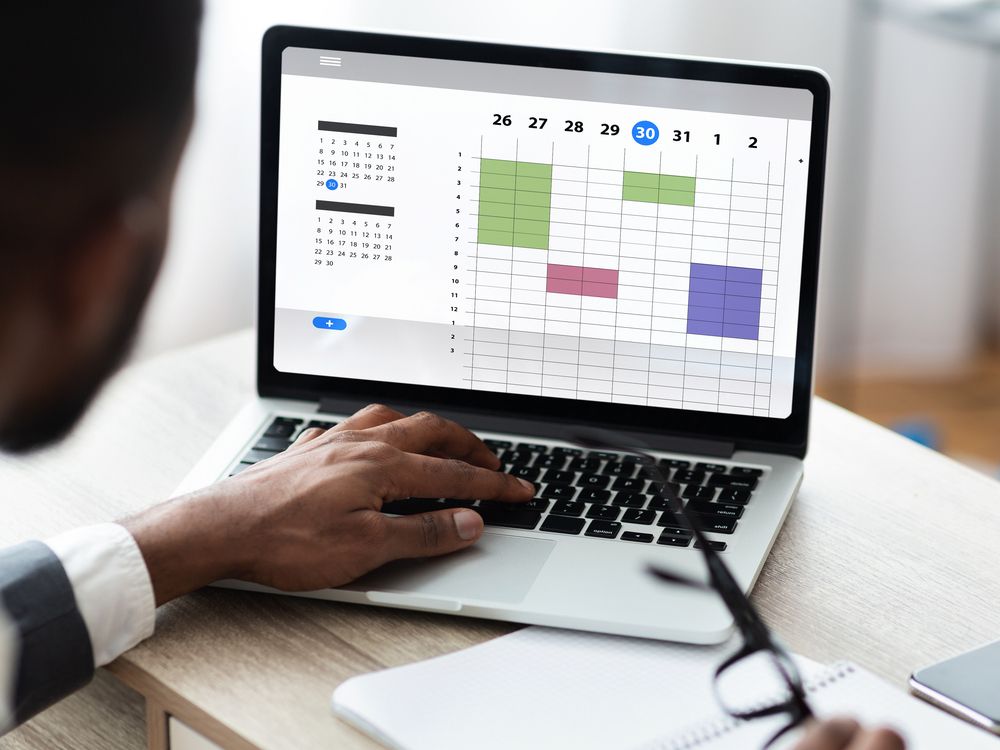People have started logging off between 4 and 6 p.m. only to begin working again in the evening in search of uninterrupted focus time

Article content
Remember the nine-to-five? I don’t. I’m 42. If, like me, your working life has been shaped by the 21st-century digital economy, with its 9:46 p.m. emails from the boss and Zoom meetings helpfully inserted into your calendar, the idea of everyone keeping the same hours is an unthinkable relic — like three-martini lunches, or inflation-beating pay rises. What a way to make a living!
Advertisement 2
Article content
No, the modern working day is more like a long and diffuse arc that begins with emails in bed at 7 a.m. and ends when the laptop is finally powered down at 11:23 p.m. The weekends are no longer time off — Sunday, between 3 p.m. and 6 p.m., is now the best time to send internal emails — it’s when they are most likely to be opened.
Article content
There is, however, a small mercy — a brief “lull” in the late afternoon, around 4 p.m. to 6 p.m. For working parents, these are the hours of the school run, perhaps some light chores, then dinnertime, bath time and bedtime stories. For those without caring duties, the lull might even be a time for beauty treatments, early restaurant bookings or exercise classes. Fitness instructors, beauty therapists and people who run golf courses say 4 to 6 p.m. is now the time when their business is booming, reporting a shift toward mid-week afternoon bookings now that, post-COVID, 44 per cent of us regularly spend some of the week working from home. The lull is certainly not a time to schedule a meeting or get a rapid answer from your boss.
But really, this is not shirking — merely deferring. The late-afternoon lull is followed by the Great Resumption in the cool of the evening. Ask Erika Brodnock, chief executive of the flexible working company Kinhub and mother of five: “I work for an hour between seven and eight in the evening,” she says. “I don’t tend to log off as early as four, but by about half-past five I’m getting my dinner on the table and then I let my team know I’ll be back online again about half past eight until the small hours.”
Advertisement 3
Article content
She presents this as something she’s fairly OK with, as her own boss. If we want everyone to play a productive part in the economy, it is essential to recognize that everyone has different needs, she stresses. “It’s far better to allow people to go and do what they need to do with their family, so that when they are working, they’re not consumed with guilt,” said Brodnock. “Guilt just takes up all your mental faculties so what you have is someone who’s present but not really there. Which is the definition of presenteeism.”
Enshrined in law
It soon won’t be up to the goodwill of bosses in some parts of the world, either. The United Kingdom’s Flexible Working Bill — which received Royal Assent — enshrines the right for workers to request flexible working arrangements from day one of their job. “Empowering workers to have more say over where and when they work makes for more productive businesses and happier employees,” said Kwasi Kwarteng when announcing the bill in 2019. However, flexible working is a paradox. When the boundaries are so porous it is often ourselves that we end up exploiting. Yes, you may not work between 4 p.m. and 6 p.m. but the trade-off is that you are “on” the rest of the time.
Article content
Advertisement 4
Article content
There is, as with everything, potential for division — non-parents resenting parents logging off for those two hours — which is why clear communication is key. If colleagues understand why you are off line for those two hours and that you will log back on, it’s easier. And flexibility presents challenges for managers, like scheduling meetings around everyone’s working days and needs with no set timetable. But businesses are increasingly realizing that flexibility is what employees are asking for and if they are to remain attractive to them it must be taken on board.

It was researchers from Microsoft Corp. who highlighted the mid-afternoon lull after analyzing when people were most active on Microsoft Teams business software. Prior to the COVID-19 pandemic, there were two moments of peak activity: before lunch and after lunch. Now a third peak has emerged, 6 p.m. to 8 p.m., during which users are apparently 42 per cent more active on chat than they were in 2021. And this is preceded by a quieter time, 4 p.m. to 6 p.m., when activity is down seven per cent.
The report notes that workers often appreciate “the extra breathing room” that comes with working at night when all the pings and bleeps and, erm, pointless Teams meetings subside. But one researcher raised a concern: “Is this about flexibility, or is it about work encroaching on someone’s personal hours?”
Advertisement 5
Article content
Parents under pressure
Of course, most parents don’t need a software company to tell us that we work like this. I mean, here I am writing these words at 10:08 p.m. after pausing my work at 4:30 p.m. or so to collect my two-year-old from nursery. And yes, I also tossed a Frisbee back and forth with my nine-year-old in that window. I’m also generally more efficient in the evenings. And since I already pay for child care, it makes more sense to socialize, exercise, etc. in the afternoons and then finish my work when they’re in bed.
And yet: I’m freelance so this is my choice. Here is a small selection of responses I received when I canvassed opinions on “the lull” from fellow parents, male and female, fully employed and freelance: “Doing it now. I don’t like it, but there’s no realistic alternative”; “Only way to work as a single parent”; “I do this all the time and hate it. Basically means I’m ALWAYS working”; “Not having any evening work to do on a week night feels like the most decadent thing imaginable.”
One friend says he works until midnight most nights of the week. Another counters that, far from being a lull, the school-pick-up-to-bedtime window is “the opposite of a lull!” — That is, by far the most frenzied and demanding section of her day. And still another complains that she has no time to unwind and decompress before it all starts again at 6 a.m. But what can she do? As she says, “We need two salaries.” As do many of us.
Advertisement 6
Article content
I do this all the time and hate it. Basically means I’m ALWAYS working
Parent who works into the evening
In 55 per cent of British couples, both partners work full-time, according to the Office for National Statistics. Meanwhile, the Resolution Foundation has calculated that workers in the U.K. are on average £11,000 worse off a year after 15 years of “almost completely unprecedented” wage stagnation. “It’s always discussed in the context of parents because they’re the ones who absolutely have to have that flexibility,” said Cathy McCosker, a HR consultant. “In a lot of cases, it is necessary for both parents to be working full-time. It’s house prices. It’s the cost of living. It’s the cost of child care. So, it’s not a luxury.”
And from the parents’ perspective, the 4 p.m. to 6 p.m. window feels anything but a lull, says Jess Lancashire, founder of From Another, which helps organizations and individuals manage flexible work. “People are trying to cram an awful lot into those hours and then they have this sense that they need to make up for that time. Being an ideal worker requires you to be at the behest of your organization almost 24 hours a day. In the U.K., there is an ideal of parenthood where you meet all the needs of your children. What we’re increasingly hearing is that this is completely unsustainable. People are either serving the needs of their job or the needs of their children, and they have no space for themselves.”
Advertisement 7
Article content
She cites one man she advocated for who works in banking. “He has two young girls and he had decided to cut his hours by about 15 per cent — with a reduction in his salary — in order to be able to pick them up from school sometimes. The thing he hadn’t anticipated was that he was demoted for this. And even then he feels the need to make up the time, so he spends until 11 p.m. doing work he is no longer being paid to do.”
Workforce dynamics
But while parents are often at the sharp end, this shift has effects across businesses, says Dr. Stefanie Gustafsson, co-director of the Centre for Future of Work at Bath University. “We know people who have a preference for working from home tend to be more senior, in the later stages of their working life, when perhaps they have more caring responsibilities,” she said. “But we need to be aware of more junior colleagues who prefer to work in the office.”
She outlines a familiar scenario. A boss sends an email at 9:46 p.m. because that’s the only time they could find to send it. This creates an ambient pressure on the junior colleague whose phone pings while they’re decompressing in the pub. “I’m not sure that young professionals always realize that they can say no — they don’t have to respond immediately. I think organizations could put a few more protections in place.” Gustafsson urges those who work unconventional hours to add a message to their email signature, emphasizing that “just because this is when I work, it doesn’t mean it has to be when you work.”
Advertisement 8
Article content

Gustafsson also points me towards some new research from the Stockholm School of Economics which shows a malign new trend caused, in large part, by digital management software like Microsoft Teams and Slack. “Yes, we’ve become more flexible in terms of how we structure our working day — when to work, where to work and so on,” she said. “But interestingly, people seem to be reporting less control of how they structure each working hour. People often have very little control over what gets put in their digital calendar, so they have to put a lot of effort into protecting their working hours. So, perhaps this lull is our way of coping with our more intense working day.”
It’s surprising how common a complaint this is among those who keep some semblance of a 20th-century nine-to-five. One friend complains that if she goes into her office, her hours are rapidly filled by everyone else’s ideas of what she needs to do — meaning the only time she has to do the job she’s actually paid to do is when everyone else has gone home. Or to put it another way, in her own time. “This is what the Microsoft report tells us,” said Gustafsson. “You need the hours in the evening to actually get the job done. Because a lot of what we do at work is not getting the job done. It makes you wonder what our jobs actually are in the first place and why we do them.”
Advertisement 9
Article content
The shape of the working day
Rob Briner, professor of organizational psychology at Queen Mary University of London, stresses that while there has been backlash against hybrid working in some parts of the corporate world post-COVID, most employers recognize it’s not really a problem. “The fact that some employees have to stop working in the late afternoon and then resume later — most of them wouldn’t really care, to be honest.”
It might be a problem when it’s hard to synchronize people for meetings, he concedes, but really he wonders whether this evolution of the working day is as novel as it might appear. It wasn’t so long ago that farmers, craftspeople and small business owners of every description would have performed their work as and when it suited them. The nine-to-five is a relatively recent invention — a product of the industrial age labour movement. Almost every aspect of life has changed since then. Why shouldn’t the shape of the working day?
-

Why 5 days in the office just don’t add up anymore
-

Hybrid work is getting better for women
-

Workers resisting the office are suddenly lonely at home
Advertisement 10
Article content
“The thing I don’t like about flexible working is, you’re flexing around an industrial age system,” said Lizzie Penny, author of Workstyle, which argues for a more fundamental shake up of working patterns to suit not only parents, but older workers, carers, people with disabilities, the neurodivergent, and others excluded by our ingrained habits. “We live in a digital age and we need a new system of work. You shouldn’t have to beg to work in a way that suits you. You should be trusted to deliver what you need to deliver.”
And in the meantime, surely fewer meetings is a good thing.
Additional reporting by Tim Sigsworth
Article content
#late #afternoon #break #killing #traditional #working #day

















Comments
Postmedia is committed to maintaining a lively but civil forum for discussion and encourage all readers to share their views on our articles. Comments may take up to an hour for moderation before appearing on the site. We ask you to keep your comments relevant and respectful. We have enabled email notifications—you will now receive an email if you receive a reply to your comment, there is an update to a comment thread you follow or if a user you follow comments. Visit our Community Guidelines for more information and details on how to adjust your email settings.
Join the Conversation